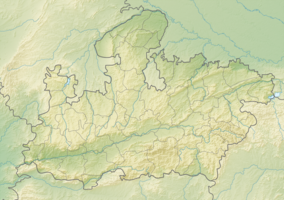Kuno National Park
| Kuno National Park | |
|---|---|
| Location | Madhya Pradesh, India |
| Coordinates | 25°30′00″N 77°26′00″E / 25.50000°N 77.43333°ECoordinates: 25°30′00″N 77°26′00″E / 25.50000°N 77.43333°E |
| Area | 748.76 km2 (289.10 sq mi) |
| Established | 1981 |
Kuno is a national park in Madhya Pradesh, India.[1] Established in 1981 as a wildlife sanctuary with an area of 344.686 km2 (133.084 sq mi) in the Sheopur and Morena districts, it was also known as Kuno-Palpur and Palpur-Kuno Wildlife Sanctuary.[2] In 2018, it was given the status of a national park. It is part of the Khathiar-Gir dry deciduous forests ecoregion.[3]
History[edit]
Kuno Wildlife Sanctuary was established in 1981 with an initial area of about 344.68 km2 (133.08 sq mi).[2] In the 1990s, it was selected as a possible site to implement the Asiatic Lion Reintroduction Project, which aimed at establishing a second lion population in India.[4] Between 1998 and 2003, about 1,650 inhabitants of 24 villages were resettled to sites outside the protected area.[2] Most of the inhabitants were Saharia tribal people. The villages were also home to Jatav, Brahmin, Gujjar, Kushwaha and Yadav people.[5] An area of 924 km2 (357 sq mi) surrounding the wildlife sanctuary was added as buffer zone to human settlements.[4]
In 2009, Kuno Wildlife Sanctuary was also proposed as a possible site for Cheetah reintroduction in India.[6]
In December 2018 the state government changed the status of the wildlife sanctuary to Kuno National Park and enlarged the protected area by 413 km2 (159 sq mi).[1]
Wildlife[edit]
Flora[edit]
The vegetation of the protected area includes Anogeissus pendula forest and scrub, Boswellia and Butea forest, dry savanna forest and grassland and tropical riverine forest. The dominant tree species are Acacia catechu, Salai Boswellia serrata, Tendu Diospyros melanoxylon, Palash Butea monosperma, Dhok Anogeissus latifolia, Acacia leucophloea, Ziziphus mauritiana and Ziziphus xylopyrus. Prominent shrub species include Grewia flavescens, Helicteres isora, Hopbush viscosa, Vitex negundo. Grass species include Heteropogon contortus, Apluda mutica, Aristida hystrix, Themeda quadrivalvis, Cenchrus ciliaris and Desmostachya bipinnata. Senna tora and Argemone mexicana are also common.[7]
Fauna[edit]
The main predators occurring in the protected area are Indian leopard, jungle cat, sloth bear, dhole, Indian wolf, golden jackal, striped hyena and Bengal fox. Ungulates include chital, Sambar deer, nilgai, four-horned antelope, chinkara, blackbuck and wild boar.[4][7] More than 1,900 feral zebu were estimated to occur in 2008, whereas density of wild ungulates was considered too low to sustain an introduced lion population at the time.[4]
Honey badger, Indian grey mongoose, ruddy mongoose, small Asian mongoose, gray langur, Indian crested porcupine and Indian hare have also been recorded. Reptiles present include mugger crocodile, Gharial, Bengal monitor and Indian softshell turtle.[7]
A total of 129 bird species were sighted during a survey in spring 2007. Indian white-backed vulture, long-billed vulture, red-headed vulture, Egyptian vulture, crested serpent-eagle, short-toed snake eagle Bonelli's eagle, white-eyed buzzard, changeable hawk-eagle, brown fish owl and spotted owlet are resident raptors. Western marsh-harrier, pied harrier, Montagu's harrier, steppe eagle, osprey, common kestrel, short-eared owl, Demoiselle crane and common crane are winter visitors.[8]
Avifauna also includes black-shouldered kite, painted spurfowl, ruddy shelduck, Indian peafowl, grey francolin, Eurasian nightjar, jungle nightjar, Indian nightjar, painted sandgrouse, woolly-necked stork, great stone-curlew, Sirkeer malkoha, Indian golden oriole, black-rumped flameback, bay-backed shrike and Indian paradise flycatcher.[7][8]
See also[edit]
References[edit]
- ↑ 1.0 1.1 Naveen, P. (2018). "Madhya Pradesh: Kuno notified as national park, path clear for Gir lions". Times of India. Retrieved 3 January 2018.
- ↑ 2.0 2.1 2.2 Kabra, A. (2009). "Conservation-induced displacement: a comparative study of two Indian protected areas" (PDF). Conservation and Society. 7 (4): 249−267. doi:10.4103/0972-4923.65172.
- ↑ "Khathiar-Gir dry deciduous forests". Terrestrial Ecoregions. World Wildlife Fund. Retrieved 29 January 2017.
- ↑ 4.0 4.1 4.2 4.3 Khudsar, F. A.; Sharma, K.; Rao, R. J.; Chundawat, R. S. (2008). "Estimation of prey base and its implications in Kuno Wildlife Sanctuary". Journal of the Bombay Natural History Society. 105 (1): 42–48.
- ↑ Kabra, A. (2003). "Displacement and rehabilitation of an Adivasi settlement: case of Kuno Wildlife Sanctuary, Madhya Pradesh" (PDF). Economic and Political Weekly: 3073–3078.
- ↑ Ranjitsinh, M. K.; Jhala, Y. V. (2010). Assessing the potential for reintroducing the cheetah in India. Noida and Dehradun: Wildlife Trust of India and Wildlife Institute of India.
- ↑ 7.0 7.1 7.2 7.3 Bipin, C. M., Bhattacharjee, S., Shah, S., Sharma, V. S., Mishra, R. K., Ghose, D., & Jhala, Y. V. (2003). Status of prey in Kuno Wildlife Sanctuary, Madhya Pradesh. Dehradun: Wildlife Institute of India. doi:10.13140/RG.2.1.1036.2005.
{{cite book}}: CS1 maint: uses authors parameter (link) - ↑ 8.0 8.1 Ramesh, T.; Sridharan, N.; Kalle, R. (2011). "Birds of Kuno Wildlife Sanctuary, Central India". Zoos' Print. 26 (12): 25–29.
External links[edit]
- Johnsingh, A. J. T. "Kuno is ready to receive lions from Gujarat" (PDF).
- Khudsar. F. A. (2001). "Kuno: Asiatic Lion's second home in making". Archived from the original on 18 January 2007.
- News articles with keyword "Palpur-Kuno" on Times of India Website.
- "Kuno Wildlife Sanctuary". Indian Government's National Web Portal. Archived from the original on 17 March 2007.
- "Latest News on "Palpur-Kuno SA"". India Environment Portal. Archived from the original on 5 October 2010.
- "Kuno Wildlife Sanctuary" (re-introduction site of wild Asiatic lions), Forest Department, State Government of Madhya Pradesh, India
- AAj Tak Video News Report in Hindi available on Youtube: Gir lions in palpur kuno century report rajesh badal.mp4 by Rajesh Badal uploaded on 14 Feb 2011
- Vikram Nanjappa - Kuno WLS, gaur36's journal a blogpost
- Video on Youtube: India Cheetah Re-introduction. Uploaded by ccfcheetah on 19 Jan 2012; The Cheetah Conservation Fund CCF has been working on and advisory capacity with the Wildlife Trust of India and India's authorities to discuss the best strategies for re-introducing cheetahs in India. For more information visit www.cheetah.org



